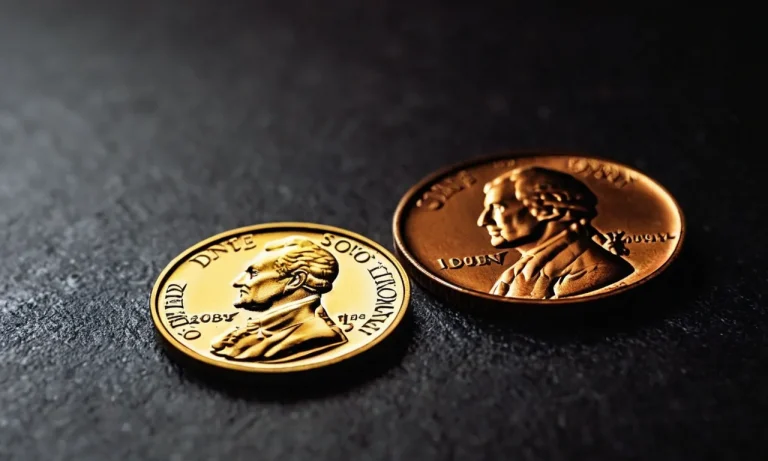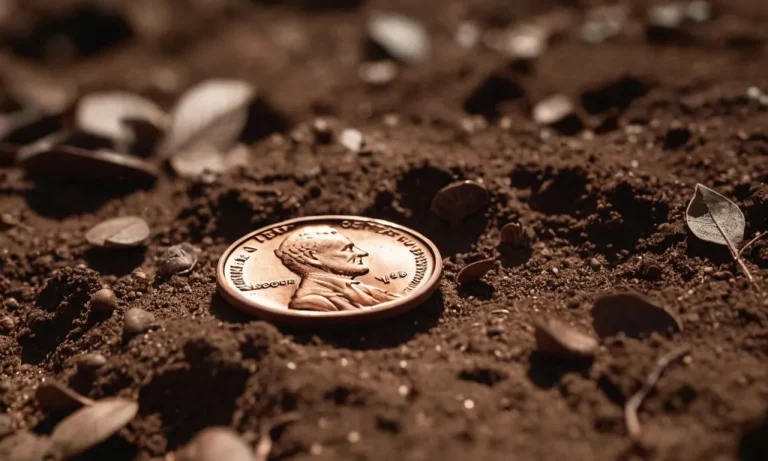Where is the mint mark on a 1883 silver dollar? The 1883 silver dollar holds intrigue for coin collectors and history enthusiasts alike. With multiple mints producing coins that year, identifying the mint is key.
If you’re short on time, here’s the quick answer: the mint mark on an 1883 silver dollar can be found on the reverse side below the eagle, just above the “DO” in the word “DOLLAR”.
In this comprehensive guide, we will cover everything you need to know about finding the mint mark on your 1883 Morgan silver dollar, one of the most iconic coins in American history.
A Brief History of the Morgan Silver Dollar
The Birth of the Morgan Silver Dollar
The Morgan silver dollar was first minted in 1878 after the Coinage Act of 1873 demonetized silver and caused an outcry from western miners and others who wanted silver to regain monetary status. Named after its designer, George T. Morgan, the Morgan dollar was minted from 1878 to 1904, and again in 1921.
It was the first standard silver dollar minted since the production of the previous Liberty Seated silver dollar ended in 1873.
Weighing 26.73 grams with 90% silver and 10% copper composition, the coin featured a profile depiction of Lady Liberty on the obverse side and an eagle with olive branches on the reverse. More than half a billion Morgan dollars were struck across five U.S. Mint facilities before the series was replaced by the Peace dollar in 1921.
Major Mint Facilities in 1883
In 1883 when the 1883 Morgan silver dollars were minted, there were four operational mint facilities:
- The Philadelphia Mint produced over 12 million Morgan dollars in 1883. As the first and main branch of the U.S. Mint, it had a high capacity for coin production.
- The San Francisco Mint generated more than 6.2 million Morgan dollars that year. As the closest mint to Nevada’s Comstock Lode, it received large silver deposits for coinage.
- The New Orleans Mint made over 8.7 million Morgans in 1883 before closing in 1909. It was the only mint to mint coins during the Confederate States of America period.
- The Carson City Mint struck around 1.2 million pieces in 1883. Located near the silver mines of Nevada, it specialized in minting silver coins.
The vast majority of 1883-dated Morgans came from the Philadelphia, San Francisco, and New Orleans Mints. And while Carson City pieces are rarer, all 1883 Morgan dollars are very common across the series with millions having entered circulation at the time.
Identifying Marks on an 1883 Morgan Silver Dollar
Understanding Mint Marks
Mint marks are small letters stamped on coins to indicate at which US mint the coins were manufactured. For example, coins struck at the Philadelphia Mint generally do not have a mint mark, while those struck at the Carson City Mint feature a small “CC” near the bottom of the coin’s reverse (tails) side.
On Morgan silver dollars like the 1883, mint marks can be found on the eagle (bird) side of the coin, near the bottom under the wreath. Common mint marks to look for include:
- No mint mark – Philadelphia
- O – New Orleans
- S – San Francisco
- CC – Carson City
So if you have an 1883 Morgan silver dollar with an “O” near the bottom on the reverse, that means it was struck at the New Orleans Mint that year.
1883 Mint Mark Locations
Specifically in terms of the 1883 date, Morgan dollars were minted in four mints that year:
The 1883-O New Orleans issue actually had one of the higher mintages that year at over 8 million coins. So it’s one of the more common dates. The 1883-CC from Carson City meanwhile had a relatively low mintage of just 1.2 million, making it valuable to collectors when in nice condition.
So in review, if you have an 1883 Morgan silver dollar, check the bottom of the reverse near the wreath for an O, S, CC, or no mint mark, to identify where it was made. This small letter has a big impact on the coin’s value to collectors today!
Tips for Verifying Authenticity of 1883 Dollars
Examine Overall Wear and Tear
Carefully inspecting the overall wear and tear of an 1883 silver dollar can provide clues about its authenticity. Genuine coins will show even, uniform wear rather than excessive damage in some areas. Check for signs of cleaning or mechanical damage that could indicate a counterfeit.
Using a magnifying glass helps spot abnormalities. Compare wear patterns with images of verified specimens in coin grading guides. An 1883-CC or 1883-O silver dollar that looks lightly circulated for its age may have been artificially worn down.
Use a Magnifying Glass on the Details
Analyzing detail elements requires magnification for detecting fakes. Study the coin’s reeding (ridges on edges), the relief and depth of its design features, text fonts, the hair detail on Lady Liberty, and more.
Genuine 1883 silver dollars have crisp, well-defined details showing slight smoothing from natural wear. Counterfeits tend to have blurry, indistinct elements or otherwise look “off.” An eye is drawn to anomalies.
Ensure details match the mint that struck each coin – Carson City (CC), New Orleans (O), Philadelphia (no mint mark).
Compare Weight and Dimensions
Using a precision digital scale and caliper allows numerically verifying an 1883 dollar’s specifications against official U.S. mint standards. An authentic coin weighs 26.73 grams and measures 38.1 mm in diameter and 2.5 mm thick.
Any deviation indicates a fake, altered coin, except possibly a very slight shortage in weight on heavily worn “slider” dollars. Comparing dimensions also screens for replicas that are cast or struck undersized.
The Significance of Each 1883 Mint Mark
1883 Philadelphia Mint Mark (No Mint Mark)
The 1883 Philadelphia silver dollars hold great historical importance as they were struck at the Philadelphia mint in enormous numbers, with over 12 million pieces produced. The coins have no mint mark since at that time the Philadelphia Mint was the main facility striking coins for circulation.
These dollars are quite common today relative to other dates, especially in well-worn circulated conditions. However, specimens in pristine uncirculated grades can be challenging to locate and fetch moderate premiums among collectors and investors seeking high-quality examples of early Morgan silver dollars.
1883 Carson City Mint Mark (CC)
Bearing the famous “CC” mint mark of the legendary Carson City Mint in Nevada, only 1.2 million 1883-CC silver dollars were struck. This tiny original mintage makes these coins a highlight in the Morgan Dollar series and widely sought after by enthusiasts.
Today, most survivors show evidence of wear and time spent in commerce. It’s exceptionally rare to locate a Carson City 1883 dollar in mint state condition. When found, uncirculated coins trade for five-figure sums even in an average state of preservation.
1883 New Orleans Mint Mark (O)
The New Orleans Mint struck 8.7 million silver dollars in 1883 bearing the “O” mint mark. While this seems abundant, attrition was high and today the issue is scarcer, especially in the finest condition grades.
An 1883 New Orleans silver dollar in MS-63 or higher grade can sell for $2,000+ owing to demand from series specialists. Select rare pieces exhibiting colorful pastel toning can push this figure even higher. As such, inspecting these coins closely is warranted before offering for sale.
1883 San Francisco Mint Mark (S)
The San Francisco Mint produced Morgan silver dollars for the first time in 1878. In 1883, it turned out 6.2 million examples bearing the mint’s distinctive “S” mint mark.
Coins saw heavy use in commerce on the West Coast resulting in most pieces surviving today grading VF, XF, or AU. While obtainable in the lower uncirculated grades, the issue becomes scarce in MS-64 and very rare any finer.
This date is always in demand by branch mint-type collectors seeking high-quality San Francisco Morgans.
Caring for and Preserving 1883 Morgan Dollars
Safe Handling and Cleaning Methods
1883 Morgan silver dollars are highly prized by collectors for their rarity, design, and silver content. Proper handling and storage are crucial to preserving these 136+ year-old coins in excellent condition.
When handling an 1883 Morgan, it’s vital to grasp the coin by its edges and wear cotton gloves. This prevents the oils and dirt from your skin from coming into contact with the coin’s surfaces. Any marks, scratches, or fingerprints can significantly reduce the coin’s eye appeal and value.
Despite what some may claim, cleaning an 1883 Morgan dollar substantially reduces its value. Collectors highly prize original surface toning that developed over more than a century of storage. This toning cannot be recreated artificially.
Acceptable cleaning methods are limited to using a soft brush and distilled water to gently remove loose dirt and debris. Harsh chemicals or abrasives that might scratch or alter the coin’s original finish should always be avoided.
Choosing a Proper Holder or Storage Container
For long-term storage, 1883 Morgans are best kept in inert plastic holders or capsules designed specifically for coins. These holders protect the coin from exposure to air, moisture, and potential physical damage.
When selecting a holder, ensure it is made from a chemically stable plastic like polyethylene or polypropylene. Materials like PVC can interact with a coin’s surfaces over time. Airtight holders with gaskets provide the most protection.
Popular storage options include 2×2 cardboard holders, hard plastic capsules, or certified third-party graded slabs from companies like PCGS or NGC. Each offers progressively better protection balanced against the convenience of storage.
Regardless of holder type, be sure to select sizes appropriate for Morgan dollars to allow adequate space and prevent scratching. Store coins in a cool, dark place to best preserve metal and toning condition.
Where Is The Mint Mark On A 1883 Silver Dollar – Conclusion
With mint marks signifying origin and rarity, properly identifying the mint mark on your 1883 Morgan silver dollar is key to determining its history and value. By understanding where to look and what marks signify which mint, you can verify authenticity and learn more about your coin’s background.
We covered everything from the mints producing coins in 1883 to decoding tiny letter marks and caring for these iconic pieces. Whether collecting for enjoyment, investment, or to hold an intriguing piece of history in your hands, the 1883 Morgan silver dollar has much to discover.



